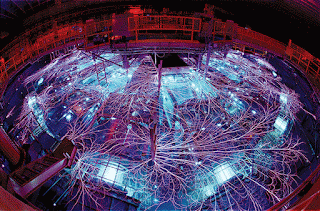Figure 1. To squeeze liquid deuterium into its metallic phase, researchers discharged the 2160 capacitors of Sandia National Laboratories’ Z machine and sent a precisely shaped 1-μs current pulse that delivered 2 MJ of energy to a target at the machine’s center. The power transmission cables, as big around as small cars, are submerged in oil or deionized water, which serves as an insulator. Electrical arcs that play over the device during discharge, shown here, make for a dazzling display. (Photo by Randy Montoya/Sandia National Laboratories.)
Citation: Phys. Today 68, 9, 12 (2015); http://dx.doi.org/10.1063/PT.3.2899
Topics: Condensed Matter Physics, Electrical Engineering, Materials Science, Solid State Physics
The world’s strongest pulsed-power source takes a shot at an 80-year-old condensed-matter-physics problem.
Hydrogen is the simplest and most abundant element in the universe. But that simplicity belies its often unpredictable nature. A case in point: Unlike the alkali metals that sit below it on the periodic table, hydrogen, even in its solid phase, remains a molecular insulator down to the lowest temperatures.
In 1935 Eugene Wigner and Hillard Huntington predicted that squeezing solid hydrogen to a sufficiently high pressure could cause it to shed its molecular bonds and transform into an atomic metal. The race to find the insulator-to-metal transition in hydrogen was on, but it’s turned out to be a marathon rather than a sprint.
High-pressure experiments are notoriously difficult, and ones on hydrogen even more so. Diamond-anvil cells, the go-to equipment for static-compression experiments, are hampered by hydrogen’s tendency to penetrate into the diamond and cause cracks. Dynamic experiments using shock compression reach higher pressures, but they heat the sample to high temperatures and only access specific values of pressure and temperature that depend on the system’s initial state. Still, experimentalists have subjected hydrogen to pressures of 320 GPa using static techniques and 500 GPa using dynamic methods but have not found the metallic phase.
Physics Today: Liquid deuterium pressured into becoming metallic, Sung Chang

Comments